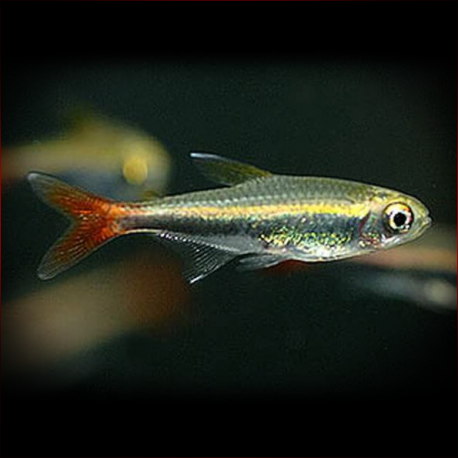More info
Datasheet
| Minimum Tank Size | 60 litres / 15.85 US gallons |
| Maximum Size | 2.5cm / 0.98inches |
| Temperature | 22°C / 71.60°F - 28°C / 82.40°F |
| Hardness | 1.01dgH / 18ppm - 8.01dgH / 143ppm |
| pH | 5.0-7.0 |
General Description
Hyphessobrycon loretoensis is a relatively popular aquarium fish with a striking brick red to orange-red caudal fin. It belongs to the Characidae family and is part of the putative H. agulha-group of closely-related species within the genus. Notable features include a moderately long, pointed snout, 10-11 predorsal scales, and a body design that fits less than 3.6 times in standard length.
Aquarium Setup
When setting up an aquarium for H. loretoensis, it is recommended to include a sandy substrate, driftwood roots, branches, and dried leaf litter for a natural feel. The fish can thrive in a planted environment and benefit from microbe colonies that grow on decomposing leaf litter. The tank should be of at least 60 liters, and water conditions should ideally have a pH range of 5.0-7.0, hardness of 18-143ppm, and a temperature of 22-28°C. (see table)
Behaviour
Known for its peaceful nature, the Loreto Tetra is suitable for community tanks. It should ideally be kept with other similarly-sized peaceful fish, such as characids, gasteropelecids, and smaller catfish. Maintaining a mixed-sex group of 8-10 individuals can encourage natural behavior and provide a visually appealing spectacle. Schooling fishes can be added to enhance the sense of security within the habitat.
Feeding and Diet
H. loretoensis is likely omnivorous, feeding on small invertebrates, crustaceans, algae, fruit, and more in the wild. In aquariums, they can survive on dried foods but thrive on a varied diet that includes live and frozen options like bloodworm, mosquito larvae, Daphnia, and Moina. Offering a diverse menu ensures the best health and coloration for these fish.
Reproduction & Dimorphism
These tetras are egg-scattering free spawners that exhibit no parental care. In well-conditioned adults, spawning can occur frequently. If breeding is desired, a separate aquarium with dim lighting and suitable substrate for egg collection is recommended. Females are typically rounder-bodied and larger, providing a visual distinction between the sexes.
Habitat and Distribution
Natively found in the upper Amazon River basin, H. loretoensis extends westward from Leticia in Colombia to the upper rio Napo basin in Peru and Ecuador. It inhabits forest streams and minor tributaries, often in areas with overhanging vegetation, submerged branches, and stained water due to organic matter decomposition. The species has been reported in various locations within the Amazon region, showcasing a wide distribution range.

